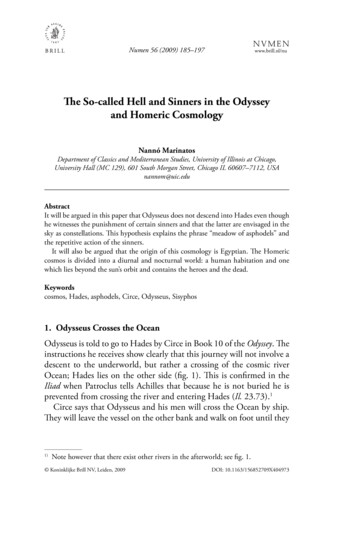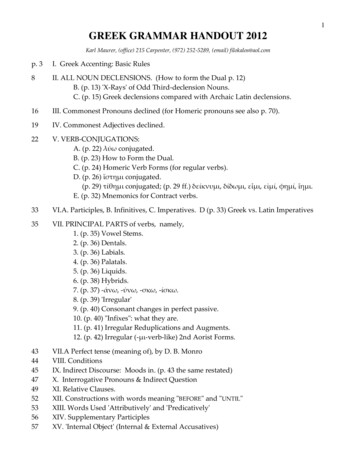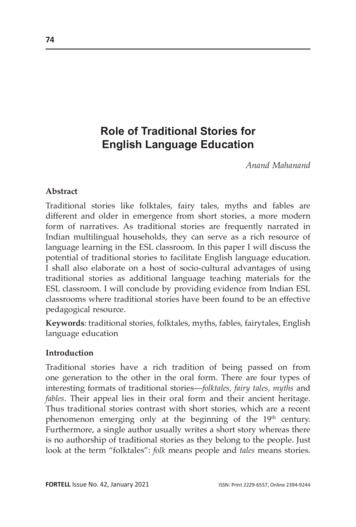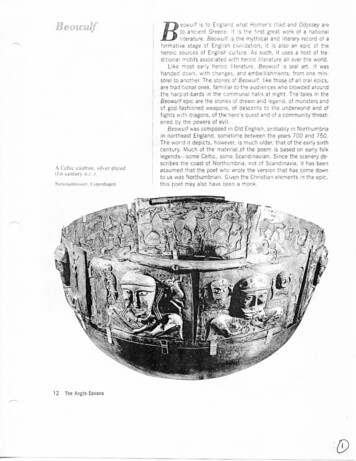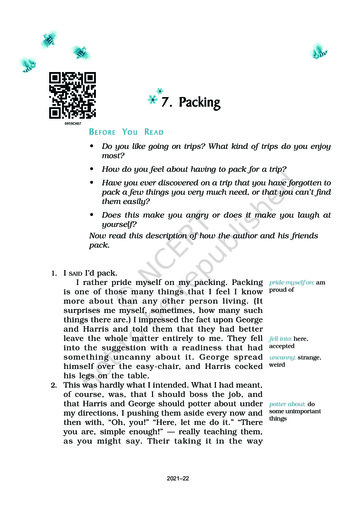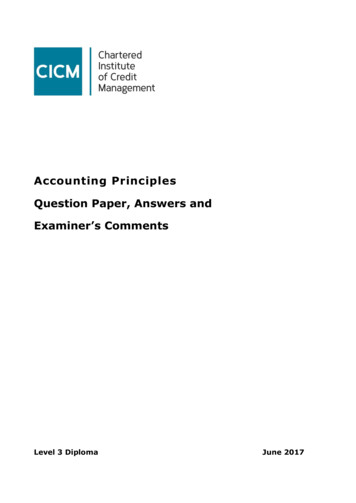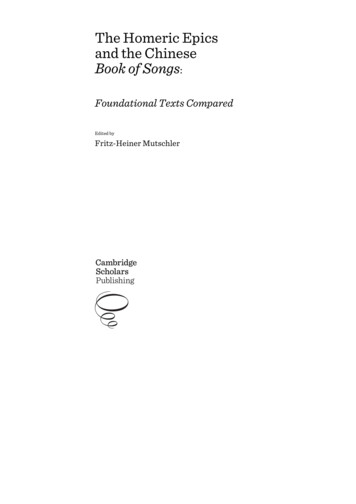
Transcription
The Homeric Epicsand the ChineseBook of Songs:Foundational Texts ComparedEdited byFritz-Heiner Mutschler
The Homeric Epics and the Chinese Book of Songs:Foundational Texts ComparedEdited by Fritz-Heiner MutschlerThis book first published 2018Cambridge Scholars PublishingLady Stephenson Library, Newcastle upon Tyne, NE6 2PA, UKBritish Library Cataloguing in Publication DataA catalogue record for this book is available from the British LibraryCopyright 2018 by Fritz-Heiner Mutschler and contributorsAll rights for this book reserved. No part of this book may be reproduced,stored in a retrieval system, or transmitted, in any form or by any means,electronic, mechanical, photocopying, recording or otherwise, withoutthe prior permission of the copyright owner.ISBN (10): 1-5275-0400-XISBN (13): 978-1-5275-0400-4
ContentsAcknowledgmentsConventions and AbbreviationsNotes on ContributorsIntroductionviiixxi1PART I. THE HISTORY OF THE TEXTS AND OF THEIR RECEPTIONA. Coming into Being1. The Formation of the Homeric EpicsMargalit FINKELBERG2. The Formation of the Classic of PoetryMartin KERN3. Comparing the Comings into Beingof Homeric Epic and the ShijingAlexander BEECROFT153973B. “Philological” Reception1. Homeric Scholarship in its Formative StagesBarbara GRAZIOSI2. Odes Scholarship in its Formative StageAchim MITTAG3. The Beginning of Scholarshipin Homeric Epic and the Odes: a ComparisonGAO Fengfeng / LIU Chun87117149C. Cultural Role1. Homer in Greek Culturefrom the Archaic to the Hellenistic PeriodGlenn W. MOST2. Cultural Roles of the Book of Songs: Inherited Language,Education, and the Problem of CompositionDavid SCHABERG3. Canon, Citation and Pedagogy:the Homeric Epics and the Book of PoetryZHANG Longxi163185207
viContentsPART II. THE TEXTS AS POETRYA. Form and Structure1. Iliad and Odyssey: Homer’s Epic NarrativesFritz-Heiner MUTSCHLER / Ernst A. SCHMIDT2. The Shijing: The Collection of Three HundredCHEN Zhi / Nick M. WILLIAMS3. Comparing Form and Structure in Homer and the ShijingZHANG Wei229255283B. Contents1. Iliad and Odyssey: Story, Concerns, ScenesØivind ANDERSEN2. Recurrent Concerns and Typical Scenesin the Book of SongsWai-yee LI3. The Contents of the Homeric Epics and the Shijing:Comparative RemarksFritz-Heiner MUTSCHLER4. “Heroes” and “Gods” in Homer and the Classic of PoetryAndrew H. PLAKS299329359375C. Values1. Homeric Values and the Virtues of KingshipDouglas CAIRNS2. The Values of the Book of Songs and the Virtues of LeadersYiqun ZHOU3. Values Compared: Homer and the Book of SongsHUANG Yang / YAN Shaoxiang381411439Looking Backward and ForwardFritz-Heiner MUTSCHLER451Glossary of Chinese CharactersIndex of NamesIndex of Works and Passages467475485
2THE FORMATION OF THE CLASSIC OF POETRYMartin KERN1. The Formation of the Early AnthologyThe Classic of Poetry (Shijing) is the fountainhead of the Chinese poetic tradition. The individual parts of the book likely date from different times over the eight-hundred-year span of the Western Zhou (ca.1046-771 BCE), Springs and Autumns (770-453 BCE), and WarringStates (453-221 BCE) periods. According to Sima Qian’s (ca. 145-ca.85 BCE) Records of the Archivist (Shiji), the Poetry was compiled byKongzi (“Master Kong,” i.e., Confucius; 551-479 BCE) in the earlyfifth century BCE. The authors of the poems themselves are not known.Since antiquity also called The Three Hundred Poems, the text hasbeen transmitted in the form of the Mao Poetry (Maoshi), one of thefour Han dynasty (202 BCE-220 CE) exegetical traditions of the anthology that were canonized and taught at the Han imperial academy.The Mao Poetry is divided into four sections, comprising 160 “Airs ofthe States” (Guofeng), 74 “Minor Court Hymns” (Xiaoya), 31 “MajorCourt Hymns” (Daya), and 40 “Eulogies” (Song). Recently excavatedmanuscripts suggest that this division existed already by the fourthcentury BCE. The Records of the Archivist includes the following passage in its Kongzi biography:In antiquity, there were more than three thousand poems. When it cameto Kongzi, he removed their duplicates and chose [only] what could bematched to the principles of ritual. Above [in time] he selected [poetryfrom the founding ancestors of the Shang and Zhou dynasties] Xie andLord Millet, and in the middle he transmitted [poetry from] the flourishing [time of the] Yin and Zhou. Coming to the shortcomings of [theZhou] Kings You and Li, those had begun with [the affairs of] thesleeping mat Kongzi put all the three hundred and five poems to the[zither] strings and singing, seeking to harmonize the tunes of [the an-
40Martin KERNcient dances] “Shao” and “Wu,” and the “Court Hymns” and “Sacrificial Eulogies.” From here on, ritual and music were obtained and couldbe transmitted in order to accomplish the Royal Way and to completethe Six Arts.1The Records speaks of the Poetry as a unified and universally sharedtext organized by Kongzi; it does not yet speak of that text’s subsequent lineages of transmission or interpretation. The “Monograph onArts and Writings” in Ban Gu’s (32-92) late first-century CE Historyof the Han (Hanshu) takes the history of the Poetry into the early empire:The Classic of Documents states: “Poetry expresses intent, song makeswords last long.” Thus, when the heart-mind is stirred by grief or joy,the melodies of singing and chanting issue forth. To recite words iscalled poetry, to chant melodies is called song. Thus, in antiquity therewere officials to collect poetry, allowing the ruler to comprehend localcustoms, understand [his own] accomplishments and failures, and examine and rectify himself. When Kongzi committed himself to gatherthe poetry of the Zhou [dynasty], upwards [in time] he selected fromYin [i.e., the Shang dynasty], downwards he collected from [his homestate of] Lu, [assembling] altogether three hundred and five pieces. Thereason why [the anthology remained] complete after meeting with [thedisaster of the] Qin [bibliocaust] was that it had been recited [frommemory] and had not merely been [written] on bamboo and silk. Whenthe Han [dynasty] arose, Lord Shen of Lu made individual characterglosses on the poems, and Yuangu of Qi and Mr. Hán of Yan bothmade commentaries. Some [others] drew on the Springs and AutumnsAnnals and collected miscellaneous explanations but entirely missedthe basic principles [of the poems]. Compared to these failures, the Lu[commentarial tradition] comes closest. The three [Han dynasty] intellectual lineages [of Poetry exegesis, i.e., Lu, Qi, and Hán] were all arrayed [for study] in the imperial academy. In addition there was thelearning of Lord Mao who claimed for himself the commentarial tradition of [Kongzi’s disciple] Zixia. Prince Xian of Hejian was fond of[the Mao commentary], but it did not become established [at the Hanimperial academy].2Shiji 47: 1934.Hanshu 30: 1708. While the Lu, Qi, and Hán versions of the Poetry hadbeen taught at the imperial academy since the second century BCE, the MaoPoetry was accorded such status only under the nominal reign of the infantEmperor Ping (r. 1 BCE-6 CE). By the end of the second century CE, the Mao12
The Formation of the Classic of Poetry41The two passages translated here are the earliest systematic accounts of the Poetry. Both date from the early empire, that is, centuriesafter Kongzi’s lifetime (and following the Qin imperial unification of221 BCE). Both are centered on the role of Kongzi not as the authorbut as the compiler of the anthology; and neither account indicates howthe poems had come into being in the first place, or who had authoredany of them.This picture is consistent with how the Poetry is mentioned orquoted across pre-imperial and early imperial sources, including arange of recently unearthed manuscripts on bamboo and silk datingfrom ca. 300 through 165 BCE. 3 In both the manuscripts and thetransmitted literature of early China, no text from antiquity is morefrequently invoked than the Poetry, and no text is more intimatelyrelated to Kongzi (whose mention, in turn, far outnumbers that of anyother philosopher in early Chinese texts). The Poetry stands at the coreof the early Chinese textual tradition and cultural imagination. As theMaster pronounces in the Analects (Lunyu), the three hundred poemscan be “covered in one phrase: no wayward thoughts!” (Analects 2.2);with them, “one can inspire, observe, unite, and express resentment” aswell as learn “in great numbers the names of fish, birds, beasts, plants,and trees” (17.9), while those who fail to study them “have nothing toexpress themselves with” (16.13) and are like a man who “stands withhis face straight to the wall” (17.10). Moreover, if one can recite thethree hundred poems but is unable to apply them to the practice ofgoverning or to diplomatic speech when abroad, “what use is there forthem?” (13.5). In two bamboo manuscripts from Guodian, the PoetryPoetry was rapidly rising to dominance while the “three lineages” (Lu, Qi,Hán) began to fade away from the canon of classical learning, even thoughsome of their readings remained relevant, visible in quotations and allusions,in the later literary tradition; see Wang Zuomin 2005; Tanaka 2003; Kern2007.3 Primarily the “Five Modes of Conduct” (“Wu xing”) and “Black Robes”(“Zi yi”) bamboo texts from Guodian tomb No. 1 (Jingmen, Hubei province;ca. 300 BCE), the “Five Modes of Conduct” silk manuscript from Mawangduitomb No. 3 (Changsha, Hunan; before 168 BCE), the fragmentary Poetryanthology on bamboo from Shuanggudui tomb No. 1 (Fuyang, Anhui; before165 BCE), and the “Black Robes” and “Kongzi’s Discussion of the Poetry”(“Kongzi shilun”) bamboo manuscripts purchased by the Shanghai Museumon the Hong Kong antiquities market. See Kern 2005.
42Martin KERNis listed as part of the classical curriculum of the “Six Arts” (liu yi)—also mentioned by Sima Qian—and hence grouped together with theDocuments (Shu), the Rituals (Li), the Music (Yue), the Changes (Yi),and the Springs and Autumns Annals (Chunqiu).4 In the Mozi (MasterMo), we even have an early (fourth century BCE?) voice ridiculing theclassicist followers of Kongzi for being consumed with singing, dancing, and putting to music the three hundred songs.5By the late fourth century BCE, and possibly for quite some timebefore that, the Poetry was not an isolated body of literature but part ofthe larger set of moral, pedagogical, ritual, and socio-political preceptsand practices of the “Six Arts” that had gained currency across theChinese cultural realm. While the Poetry is associated with the Zhouheartland in the north, with the “Airs of the States” attributed to fifteenstates or regions stretching in an East-West corridor along the YellowRiver from modern Shandong to Shaanxi, the ancient manuscripts thatquote them all come from southern central China. The quotation patterns in these manuscripts reveal that while the writing of the poemswas not yet standardized even by the mid-second century BCE, theanthology had been largely stable in its content and possibly evenwording by around 300 BCE.6 Despite what must have been considerable differences in dialect across the vast early Chinese oikouménē, themanuscript quotations from the Poetry are phonologically (if not, indeed, phonetically) consistent with their counterparts in the receivedanthology, suggesting a spoken élite koiné in which the poems werepreserved and which, in turn, was embodied and perpetuated in canonical verse. The existence of this idiom is attested in Analects 7.18where Kongzi is said to have used “elegant standard speech” (yayan)for the Poetry, the Documents, and matters of ritual.To Han thinkers, writing from the perspective of the unified empire,the ultimate audience of the Poetry had been the Zhou king himself: aspoetry was believed to emerge as a quasi-cosmological event, naturallyand inevitably expressing the speaker’s emotional response to personalexperience, it was taken to reflect the moral and political order of itstime. Furthermore, it represented the voice of the common people—anunmanipulated voice of truth that, collected by court officials, roseJingmen shi bowuguan 1998, 179 (“Xing zi ming chu”), 188 (“Liu de”);further 194-5 (“Yucong”).5 Mozi xiangu 2001, 48.456.6 Kern 2003, 33-7; and Kern 2005.4
The Formation of the Classic of Poetry43upward to the ruler to remind him of his duties and failures. With theQin-Han empire, the notion of poetry as socio-political symptom andomen generated an exegetical tradition that turned decidedly historical,satisfying the need for a moral and political teleology that gave orderand explanation to a chaotic past and, ultimately, to the rise of the empire itself. Grasping the meaning of a poem would yield an understanding of specific historical events, turning poetry into “history told inverse.”7Yet, on the other hand, it was also acknowledged that poetry didnot speak in any direct, literal way and hence was not to be taken at itssurface meaning. It was so wide open to mutually exclusive interpretations that it caused rivaling exegetical lineages to emerge. In the earlyempire, these traditions of teaching and interpreting the Poetry oftenadvanced fundamental differences in understanding an individual poem. Nevertheless, they all agreed on the principal function of poetry asa source of historical knowledge and moral edification; and they further concurred in their general disinterest in individual authorship,poetic beauty, linguistic differences, and the possible circulation ofpoetry beyond the realms of the political élite.The nature of the Poetry as a diverse anthology of different kinds ofpoetry (likely dating from different times) suggests that it was a selection from a larger body of material—regardless of their actual or imagined number, or of the persona of their collector and compiler. Theonly figure who in Warring States and early imperial times is consistently associated with the Poetry, and who is granted unquestionableauthority over the text, is indeed Kongzi. This association of the idealtext with the ideal sage elevated the Poetry to a book of wisdom thatgave account of history as much as it did of the human condition, thatspoke of the ambitions of kings, of the plight of farmers and soldiers,and of the anxieties of lovers; it was, to borrow Stephen Owen’s characterization, “the classic of the human heart and the human mind”8 andas such was attributed to the exemplary sage. To the early tradition, itwas only in the mirror of Kongzi’s unique perspicacity and unimpeachable moral perfection that the Poetry became fully visible. Moreover, it was only with its idealized compiler that the Poetry as a bodyof text came into being, not as his words or the words of his time, but78Riegel 1997, 171.Owen 1996, xv.
44Martin KERNas a repository of expressions inherited from the past. After Kongzi,and especially with the Han imperial scholars, it was an artifact of thepast remembered—a canonical curriculum that enshrined all at oncethe poems, the course of history they marked and revealed, and theirsagely compiler and transmitter.Yet, the heavy burden placed on the cultural and historical meaningof the Poetry reveals an acute problem: while, in general, the Poetry isbelieved to contain earlier and later layers of text, with the earliestpoems possibly dating from the eleventh and tenth centuries BCE, thetextual record up to the Han anthology is extremely fragmentary. In theMao Poetry, the longest poem, “The Closed Temple” (Mao 300 “Bigong”), contains 492 characters, and several others are nearly as extensive. However, the longest quotation of any poem in any early textoutside the anthology itself contains merely forty-eight characters: oneof eight stanzas of “Great indeed!” (Mao 241 “Huang yi”) as quoted inthe Zuo Tradition (Zuozhuan), the grand pre-imperial work of historiography probably dating from the fourth century BCE.9 The only quotation of an entire poem is of “Grand Heaven Had Its AccomplishedMandate” (Mao 271 “Haotian you cheng ming”), a text of merely 30characters quoted in The Conversations of the States (Guoyu), anotherwork of early historiography possibly contemporaneous with the ZuoTradition. 10 Otherwise, the standard quotation pattern comprises asingle line, a couplet, or a quatrain. While early quotations from thePoetry number in the hundreds, they do not let us reconstruct longerpoems; often, they show a preference for particular phrases that arequoted repeatedly across various sources while other verses and entirestanzas are not quoted even once. Altogether, the presence of the individual poems in the overall textual record of early China is very uneven. This disquieting situation may explain to some extent the urgency felt by Han commentators to supply each piece in the Poetrywith a historical context: not extracted from the poems—as claimed byway of the notion that “poetry expresses intent”—but rather injectedinto them.We therefore do not know the original forms of the poems: did theyhave as many stanzas as we see in the Han anthology, or are the longest poems composite texts from various sources? Were they nearly as9Yang Bojun 1992, 1495 (Zhao 28); Legge 1985, 727.Guoyu 3.4 (“Zhou yu, xia”); Xu Yuanhao 2002, 103.10
The Formation of the Classic of Poetry45regular in their formal features? Did some of the very short poems everexist as individual texts before being anthologized as such? Was theinternal order of stanzas and lines stable? Recognizing the numerouspossibilities of retrospective editorial intervention—archaizing recomposition, formal standardization, creative compilation of disparatetextual material, acts of textual combination, division, and selection—before the poems were finally arrested within the framework of theircanonical anthology, it becomes exceedingly difficult to define whichparts are “early” and which others “late.” Any particular poem thatmight appear “early” may well be a much later artifact of commemoration and imagination. Considerable evidence suggests that some of the“early” poems are composite artifacts formed from different types andchronological strata of text.112. Sacrificial EulogiesIn general terms, Chinese poetry began to take shape in the early religious and political rituals of the Western Zhou (ca. 1046-771 BCE)royal court, including the ancestral sacrifice, banquets, and proclamations. The presumably earliest examples of poetry—especially the“Eulogies of Zhou” (“Zhou song”)—are believed to come from theearly decades of the Western Zhou dynasty.The thirty-one anonymous “Eulogies of Zhou” differ from the “Major” and “Minor Court Hymns” in both their brevity and overall lack ofthe two principal features of formal regularity in early Chinese poetry:rhyme and meter. As such, they appear as particularly archaic forms ofZhou verse employed within sacrificial ceremonies to commemorateand feast the dynastic ancestors. While semanticizing and interpretingthe sacrificial act through words of commemoration and religious expectation, poetry, always as song, was integrated into the performanceof dance and music. Judging from its linguistic properties as well asfrom the available historical accounts, this poetry existed in the context11 For a decidedly more optimistic approach to the origins of Zhou poetryand music, based on considerable speculative risks I do not feel confident totake on myself, see Chen 2007. An admirably detailed study of the Poetry inpre-imperial times, albeit traditional in its thoroughly positivistic bent, is MaYinqin 2006. For one of many earlier interpretations of the origins of thePoetry as ritualistic, see Chen 1974.
46Martin KERNof and for the purpose of synesthetic religious ceremonies.12 Fundamentally non-lyrical, non-self-expressive, and non-authored, it embodies the political and religious community of the Zhou royal court, giving voice to the reciprocal relationship between the living king and thepowerful spirits of his ancestors.Not all “Eulogies of Zhou” have left traces in the early literary tradition, 13 but the poems associated with King Wu’s conquest of theShang dynasty are particularly visible. In a narrative dated to the year595 BCE, the Zuo Tradition contains the following entry:When King Wu conquered Shang, he made a eulogy saying: “[He?]gathered and stored the shields and dagger-axes, gathered and encasedthe bows and arrows. We strive for admirable virtue, to be dispensedacross this [land of] Xia. Truly the king will preserve it!” He furthermade “Martiality,” the final stanza of which says: “[You?] made firmyour merits!” Its third [stanza?] says: “[He?] spread out this abundance;we proceed and seek for this to be established.” Its sixth [stanza?] says:“[He?] pacified the myriad states, made bounteous harvest-years comein succession.” As for martial prowess, [it lies in the sequence of] oppressing violence, storing away weapons, protecting the great [mandate?], establishing merit, pacifying the people, harmonizing the masses, and [creating] bounteous riches. Therefore [King Wu] ensured thatsons and grandsons will not forget these stanzas (or: this display ofbrilliance).1412 Wang 1988, 1-51, offers a useful survey of modern scholarship. TheChinese ancestral sacrifice is well captured in Stanley J. Tambiah’s definitionof ritual: “Ritual is a culturally constructed system of symbolic communication. It is constituted of patterned and ordered sequences of words and acts,often expressed in multiple media, whose content and arrangement arecharaterized in varying degree by formality (conventionality), stereotype(rigidity), condensation (fusion), and redundancy (repetition). Ritual action inits constitutive features is performative in these three senses: in the Austiniansense of performative wherein saying something is also doing something as aconventional act; in the quite different sense of a staged performance that usesmultiple media by which the participants experience the event intensively; andin the third sense of indexical values—I derive this concept from Peirce—being attached to and inferred by actors during the performance.” SeeTambiah 1979, 119.13 See Ho and Chan 2004. For example, only 11 out of the 31 “Eulogies ofZhou” are quoted in the Zuo Tradition.14 Xuan 12; Yang Bojun 1992, 744-6; Legge 1985, 320.
The Formation of the Classic of Poetry47While the text claims that King Wu “made” (zuo) a “eulogy” (song)apparently of several “stanzas” (zhang, also the word for “brilliantdisplay”), the individual quotations of different “stanzas” come fromfour separate “Eulogies of Zhou” (Mao 273, 285, 295, 294), not from asingle poem. Moreover, in the Conversations of the States,15 the firstand most extensive of these quotations is said to come from a “eulogy”by the Duke of Zhou (r. as regent 1042-1036 BCE). Thus, in our twoearliest sources for this text, the poems are attributed to either KingWu representing his own accomplishments or to his younger brother,the Duke of Zhou, who commemorated King Wu. Most intriguing,however, is a passage in the Han dynasty compilation Records of Ritual (Liji) where Kongzi instructs an interlocutor that “music is therepresentation of accomplishments” and goes on to describe the sixpantomimic dance movements of “Martiality” (“Wu”) that representedKing Wu’s conquest of the Shang.16At least in the cultural memory after 771 BCE, and possibly alreadyin the religious and political rituals of the Western Zhou, entire collections of dances, music performances, and poetic texts were employedto communicate the accomplishments of the dynastic founders towardboth the spiritual and the political realm. This archaic poetry originatedwith the ritual specialists of the Zhou royal court. Its preservation andtransmission depended on the Zhou political and religious institutionswhere—according to our earliest sources—it was not merely archivedbut continuously performed; and while the perspective of the speaker isusually uncertain, the use of first- and second-person personal pronouns suggests dramatic, polyvocal enactments.By the mid-first millennium BCE, after the Zhou’s suzerain powerhad declined dramatically, its cultural heritage of ritual, music, poetry,and royal speeches was known to be preserved elsewhere: the smalleastern state of Lu (in modern Shandong province), birthplace ofKongzi. If, initially, Western Zhou ritual had contained and perpetuated the poetic utterances of hymns and eulogies in the performancesGuoyu (“Zhou yu, shang”) 1.1; Xu Yuanhao 2002, 2.In the chapter “Records of Music” (“Yueji”). Liji jijie 1989, 1023-4;Legge, 1967, 2: 122-3. Modern scholars have invested great efforts inreconstructing the original sequence of “Martiality” from different poems ofthe “Eulogies of Zhou”; see Wang Guowei 1975, 2.15b-17b; Sun Zuoyun1966, 239-72; Wang 1988, 8-25; Shaughnessy 1997, 165-95; and, for anexcellent recent study, Du Xiaoqin 2013, 1-28.1516
48Martin KERNof the ancestral sacrifice and other court rituals, over time this relationship between text and ritual became reversed: by the time of Kongzi,when the old rituals had long faded, it was the archaic poetry that preserved the memory of ritual, as is amply expressed in Poetry invocations in the Zuo Tradition, the primary text to portray the Poetry as thecore of Chinese cultural memory and coherence.17Almost all “Eulogies of Zhou” are very short: of the thirty-one poems, eight have between 18 and 30 characters; nine between 31 and 40;four between 41 and 50; six between 51 and 60; and only the remaining four hymns have 62, 64, 92, and 124 characters. It is not certainthat, originally, these poems existed as discrete, self-contained textualunits: first, in the Zuo Tradition account quoted above, the eulogiesrelated to King Wu’s conquest form a single unit of several sections orstanzas (zhang) while in the Mao Poetry, they are divided into individual poems with separate titles. 18 Second, a hymn of just 18 words,accompanied by music and dance, was probably not considered (orperformed as) a text of its own. Third, some “Eulogies of Zhou” areclosely interrelated: they share entire lines or even couplets with oneanother but not with other poems, marking them as a single larger unitof text. 19 Thus, of the thirty components of characters of “Year ofAbundance” (Mao 279 “Feng nian”), sixteen are verbatim identical toverses in “Clear Away the Grass” (Mao 290 “Zai shan”). At the sametime, “Clear Away the Grass” also shares three more lines with “GoodPloughs” (Mao 291 “Liang si”), and additional individual lines withfour other neighboring texts.20 One may, thus, think of the texts of the“Eulogies of Zhou” not as individually authored texts but as variationsof material taken from a shared poetic repertoire. This repertoire waslargely confined to the “Eulogies” themselves (from which later court17 For the Zuo Tradition, see Schaberg 2001; Pines 2002; Li 2007. For atable and extensive discussion of poetry performances and possible instancesof composition in the Zuo Tradition, see Zeng Qinliang 1993.18 Note that the Zuo Tradition, unlike in many other cases of quoting fromthe Poetry, does not mention any of these titles other than “Martiality”(“Wu”).19 Thus, the brief hymns numbered 286, 287, 288, and 289 in the MaoPoetry share lines in several ways, and only with one another; in addition, theyshare a number of two-character formulas. See Dobson 1968, Appendix II,247-9.20 Mao 277, 292, 293, 294.
The Formation of the Classic of Poetry49hymns then borrowed the occasional line), operating within the formaland semantic constraints of ritual utterances. In the performance of theancestral sacrifice, they represented configurations of what Jan Assmann calls “identity-securing knowledge” that is “usually performed inthe form of a multi-media staging which embeds the linguistic textundetachably in voice, body, miming, gesture, dance, rhythm, andritual act By the regularity of their recurrence, feasts and rites grantthe imparting and transmission of identity-securing knowledge andhence the reproduction of cultural identity.” 21 Not surprisingly, the“Eulogies” are only one arena where this repertoire of memory of theZhou foundational narrative becomes realized and staged in varioustextual forms; another place is the sequence of several “harangues” (shi)in the Classic of Documents where King Wu’s conquest is recalled invarious speeches attributed to him, with the king staged as speaker.22The writing of the Poetry was not yet standardized even in Hantimes, and the different hermeneutic traditions had to make their ownchoices in constituting the written text by choosing particular characters over other (usually homophonous) ones—and even then, the archaic idiom left multiple possibilities of interpretation. While thissituation leads to massive difficulties in the understanding of the hermeneutically open “Airs of the States” (see below), it is less severe inthe case of the “Eulogies” and “Court Hymns”, despite some uncertainty over certain individual words. Altogether, these ritual poems aresemantically overdetermined in their intensity of repetitive, euphoniclanguage, enacting and doubling linguistically the sacrificial ritualsduring which their performance took place. 23 Their overall lack ofambiguity is further reflected in how the “Eulogies” were used in postWestern Zhou recitation practice as reflected in the Zuo Tradition:unlike the “Airs of the States” and “Minor Court Hymns,” which wereroutinely recited as coded communication in order to elicit a particularhermeneutic response from the addressee, the “Eulogies”, in all casesbut one,24 are quoted as proof and explanation in support of an argu-21 Assmann 1992, 56-7 (my translation); now somewhat rephrased inAssmann 2011, 72.22 Nomura 1965; Kern 2017.23 On this, see Kern 2009, 164-82.24 The single exception is found in Zhao 16; Yang Bojun 1992; Legge 1985,664.
50Martin KERNment.25 They were considered self-evident,
The Homeric Epics and the Chinese Book of Songs: Foundational Texts Compared Edited by Fritz-Heiner Mutschler This book first published 2018 Cambridge Scholars Publishing Lady Stephenson Library, Newcastle upon Tyne, NE6 2PA, UK British Library Cataloguing in Publication Data A catalogue record for this


